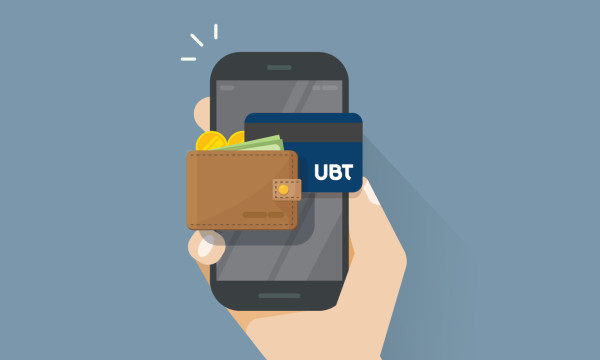What can I expect when I visit a branch?

Visiting a bank branch can be a source of anxiety for many people. Whether it’s because of a negative past experience or simply because an unfamiliar environment can feel intimidating, the thought of walking into a bank can be overwhelming. If you’ve never been to a bank before, you may not know what to expect. At UBT, our main goal is to help you be financially successful, wherever you are in life, so we’ve put together some tips that may help ease your apprehension.
Remember that bank employees want to help
One reason folks may feel anxious about visiting a bank is because they worry about being judged, or may be embarrassed about not knowing how to perform a particular banking task. We can assure you that a dedicated customer service team member (which is probably who you’ll encounter) comes to work ready to help, not to judge. At UBT, for example, we’re trained to assist customers with a variety of financial needs, and we’re people from all walks of life. While banks can seem intimidating when you’re new or have an issue, no one is there to criticize you, as we’re all just real people with real life issues of our own. Our main goal is to help you be financially successful, wherever you’re at in life; it should be reassuring to know that bank staff is there to help.
Another reason people may have some trepidation about visiting a bank branch is because they’re worried about making mistakes. They may be afraid of accidentally giving out too much information or making a wrong transaction. If you are unsure about how to do something, don’t hesitate to ask a bank employee to assist; we’re trained to help customers feel more comfortable and confident.
Know the bank is secure
Some people may feel anxious about visiting the bank because they are worried about their safety. They may be concerned about the risk of robbery or theft, especially if they’re carrying a large amount of cash. While it’s true that banks can be targeted by criminals, the risk is relatively low. There are a lot of security measures in place that customers may never see or notice. At UBT, for example, we use many layers of security, such as secured doors, cameras, and intercoms. We also ask questions to verify identity when customers are calling in or visiting the branch, so you’ll want to make sure you bring your ID and other applicable identification when you visit.
Make a plan (and bring a friend, if you want!)
It’s a good idea to plan ahead before visiting the bank — do some research and make a list of the things you need to do or the questions you want to ask. Having a plan can help you feel more in control. You could even phone ahead and make an appointment with the banker. This will give you the opportunity to discuss your needs in advance and ask any questions you may have. If possible, bring a friend or family member with you for support. They can help calm your nerves and provide a second set of ears to listen for key information.
Gather necessary documents — and possibly some cash
Before going to the bank, make sure you have all the necessary documents, including a government-issued ID (such as a driver’s license, state-issued ID card, Department of Defense ID card, or passport) and proof of your address (such as a bill). Additionally, although you won’t need to show your physical Social Security card, it’s a good idea to know the number. If you’re applying for a loan, you’ll most likely need some additional documents, so you may want to call the branch ahead of time and inquire. If you plan to open an account, you’ll need to make an initial deposit using cash, a check, or another method. A phone call to the branch, or a visit to the website, can tell you what the minimum opening amount is.
Practice what you want to say
If you’re opening an account or applying for a loan, practice what you want to say beforehand. This can help you feel more confident and prepared. You could even ask a friend or family member to role-play the scenario with you to get some extra practice.
Be prepared to answer questions
When you first enter the branch, a receptionist or other member of support staff may greet you. One of their jobs is to locate the right person to help with your specific banking needs, so they may ask a few questions to determine who might be best equipped to assist you. From there, you may be connected with a personal banker, who can help you identify financial goals and recommend specific products and services that fit. With their help, you can open accounts, apply for credit cards and loans, and manage your account. Alternatively, a loan officer, branch manager, or assistant branch manager may be the one to assist you, depending on your request and how many hats this employee is wearing. Know that whoever you meet will do their best to put you at ease!
Once you’re in front of customer service staff who can best meet your needs, more questions may follow. Know that the bank employee won’t ask you anything, other than conversational questions, that isn’t relevant to your purpose. For example, questions about your address, employer, and other contact information would help a banker to securely establish an account for you. Questions about your income, collateral, and possibly a co-signer would be asked if you were applying for a loan. And a teller might verify your identity for a withdrawal or account printout.
Additionally, with scams on the rise these days, bank personnel may ask a series of in-depth questions to verify your identity and make sure everything lines up. Please know that these aren't meant to be nosy! We just want to make sure we’re protecting you and your finances.
Ask for clarification
If you don’t understand something your banker says or something that you’re asked to sign, don’t be afraid to ask for clarification. Questions are expected; after all, it can be a lot of information at once, and our friendly experts are here to ensure that you have the best banking experience possible.
After your visit, take a moment to celebrate your accomplishments. By taking things slowly, being prepared, and asking for help when you need it, you overcame your anxiety and completed what likely felt like a daunting task. With time and experience, you can hopefully begin to feel more at ease when visiting the bank, until it becomes a normal part of managing your finances. That’s our goal for you, and probably yours, too.
If we can help you get started on your financial future — whatever that looks like for you — visit or call your nearest UBT branch today!
Learning Center articles, guides, blogs, podcasts, and videos are for informational purposes only and are not an advertisement for a product or service. The accuracy and completeness is not guaranteed and does not constitute legal or tax advice. Please consult with your own tax, legal, and financial advisors.




